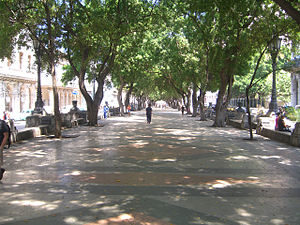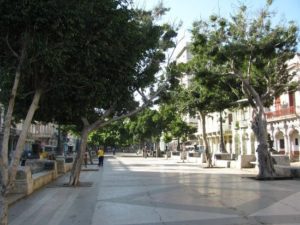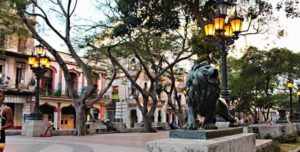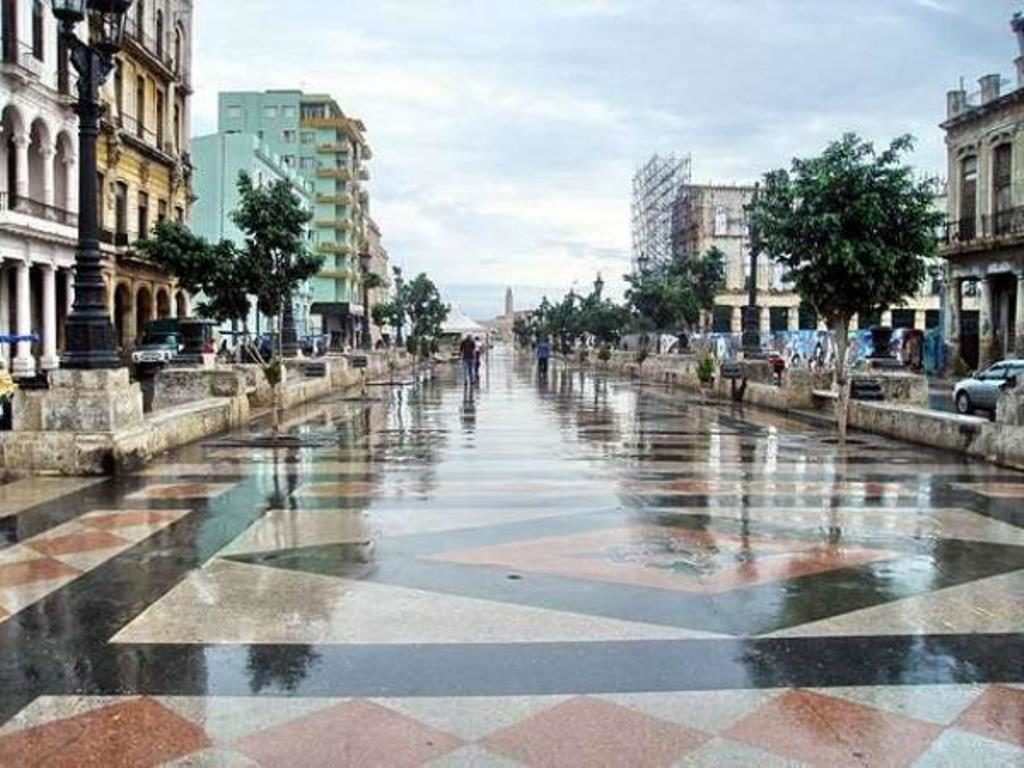 MONUMENTO HISTORICO EN EL CENTRO DE LA HABANA, EL PASEO DEL PRADO.
MONUMENTO HISTORICO EN EL CENTRO DE LA HABANA, EL PASEO DEL PRADO.
Considerado como el primer gran urbanista de la ciudad construyó el Paseo la Alameda de Paula en 1772 y dio inicio a las obras del Paseo del Prado, mejorado y embellecido luego por los gobernadores coloniales.
Céntrico, histórico y célebre está rodeado escoltado de verdaderas joyas arquitectónicas, palacios residenciales de inicios del siglo XX e importantes instalaciones culturales, sociales y comerciales que dan vida y brillantez al mismo.
Desde su construcción tuvo varios nombres: Paseo del Prado, Alameda de Extramuros, Alameda de Isabel II, Paseo del Nuevo Prado, Paseo del Conde de Casa Moré y Paseo de Martí, que es su nombre oficial.
Más de doscientos años de cultura, tradición y costumbres añejan la historia del Paseo del Prado, desde su construcción por Felipe de Fons de Viela, marqués de la Torre, nombrado capitán general de la Isla.
Se extiende desde la actual Plaza de la Fraternidad hasta el Malecón, aunque el Parque Central lo divide en dos secciones bien diferenciadas. Una de las primeras manifestaciones de renovación fue la apertura de dos alamedas o paseos al unísono con el primer teatro y los palacios de gobierno.
Un paseo salía de la puerta de Tierra de la Muralla, aledaña a la calle de ese nombre, tomaba la calle Monte y llegaba a Reina. También de tierra y a la sombra de cocales. Hacia 1841 ese paseo se convirtió en el centro de La Habana y la Plaza de Armas, oportunamente, desplazó a la Alameda de Paula como lugar de preferencia.
Y el Prado a su vez desplazó a la Plaza de Armas, por su mayor extensión y amplitud, más adecuadas a la importancia y población que iba adquiriendo la ciudad.
EL PASEO DEL PRADO, PERIODO REPUBLICANO.
En el período 1928-1929 se decidió su imagen definitiva, hasta el presente, se construyeron bancos de piedra con respaldo y base de mármol, se colocaron elementos ornamentales como copas y ménsulas en profusión a lo largo del paseo, se colocaron las farolas artísticas de hierro y los ocho leones de bronce que lo custodian desde sus pedestales.
El paseo central se pavimentó con un bello piso de terrazo. Al construirse el Capitolio el 20 de mayo de 1929, lugar que marca el kilómetro cero de la red de carreteras de Cuba, se eliminó una sección del Paseo y se remodeló la que se mantuvo, integrándose las áreas exteriores del mismo al Paseo del Prado, a la Plazoleta de la Fuente de la India, y al Parque de la Fraternidad.
Hacia fines del siglo XIX, el Paseo del Prado pasó a ser un espacio para el recorrido de peatones en lo fundamental, complementado con el nuevo Parque Central que surgió en sus inmediaciones.
Así en la vial del Paseo del Prado se ubicaron construcciones civiles de marcado uso social: sociedades de recreo, hoteles, cines, teatros, y al mismo tiempo importantes mansiones, construcciones todas de marcada filiación al eclecticismo, con las más variadas formas en el diseño.
Céntrico, histórico y célebre está rodeado escoltado de verdaderas joyas arquitectónicas, palacios residenciales de inicios del siglo XX e importantes instalaciones culturales, sociales y comerciales que dan vida y brillantez al mismo.
En la actualidad, en el entorno de la celebración de los 5 siglos de fundación de La Habana, la importante arteria combina armónicamente su estructura colonial junto a la modernidad que como valor agregado le otorgan varios majestuosos hoteles, entre los que destacan -Packard y Paseo del Prado– que se alzan frente al Malecón desafiantes del tiempo y los embates del mar y los vientos.

Ayer, Hoy, Siempre- www.THE CUBANHISTORY.COM-Yesterdays, Today, Always.
 HISTORICAL MONUMENT IN THE CENTER OF HAVANA, EL PASEO DEL PRADO.
HISTORICAL MONUMENT IN THE CENTER OF HAVANA, EL PASEO DEL PRADO.
Considered the first great city planner of the city, he built Paseo la Alameda de Paula in 1772 and began work on the Paseo del Prado, which was then improved and embellished by the colonial governors.
Central, historic and famous, it is surrounded by real architectural jewels, residential palaces of the early twentieth century and important cultural, social and commercial facilities that give life and brilliance to it.
Since its construction it had several names: Paseo del Prado, Alameda de Extramuros, Alameda de Isabel II, Paseo del Nuevo Prado, Paseo del Conde de Casa Moré and Paseo de Martí, which is its official name.
More than two hundred years of culture, tradition, and customs age the history of the Paseo del Prado, from its construction by Felipe de Fons de Viela, Marquis de la Torre, named Captain General of the Island.
It extends from the current Plaza de la Fraternidad to the Malecón, although Parque Central divides it into two distinct sections. One of the first manifestations of the renovation was the opening of two avenues or walks in unison with the first theater and government palaces.
A walk out of the door of Tierra de la Muralla, next to the street of that name, took Monte Street and arrived at Reina. Also of earth and in the shade of cocales. Towards 1841 that walk became the center of Havana and the Plaza de Armas, opportunely, moved to the Alameda de Paula as a place of preference.
And the Prado, in turn, displaced the Plaza de Armas, due to its greater extension and amplitude, more suited to the importance and population that the city was acquiring.
EL PASEO DEL PRADO, REPUBLICAN PERIOD.
In the period 1928-1929 its definitive image was decided, until now, stone benches with marble base and base were built, ornamental elements such as crowns and corbels were placed in profusion along the promenade, the artistic streetlights of iron and the eight bronze lions that guard it from its pedestals.
The central promenade was paved with a beautiful terrazzo floor. When the Capitol building was built on May 20, 1929, place that marks the zero kilometers of the road network of Cuba, a section of the Paseo was eliminated and the one that was maintained was remodeled, integrating the exterior areas of the Paseo del Prado, to the Plazoleta de la Fuente de la India, and to the Parque de la Fraternidad.
Towards the end of the 19th century, the Paseo del Prado became a space for pedestrian travel in the main, complemented by the new Central Park that emerged in its vicinity.
Thus, on the Paseo del Prado road, civil constructions of marked social use were located: recreation societies, hotels, cinemas, theaters, and at the same time important mansions, constructions all of marked affiliation to eclecticism, with the most varied forms in design.
Central, historic and famous, it is surrounded by real architectural jewels, residential palaces of the early twentieth century and important cultural, social and commercial facilities that give life and brilliance to it.
Currently, in the context of the celebration of the 5 centuries of Havana’s foundation, the important artery harmoniously combines its colonial structure with modernity as an added value given by several majestic hotels, among which stand out -Packard and Paseo of the Prado – that rise up in front of the Malecón defiant of the time and the ravages of the sea and the winds.
Agencies/ RHC/ Guadalupe Yaujar/ Internet Photos/ Arnoldo Varona/ www.TheCubanHistory.com
THE CUBAN HISTORY, HOLLYWOOD.

Ayer, Hoy, Siempre- www.THE CUBANHISTORY.COM-Yesterdays, Today, Always.



 < HISTORICAL Monument in the Center of La Havana, El Paseo del Prado. PHOTOS.
< HISTORICAL Monument in the Center of La Havana, El Paseo del Prado. PHOTOS.





